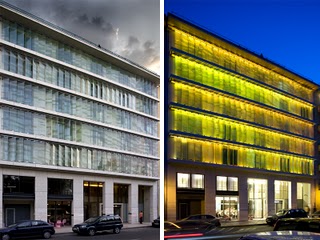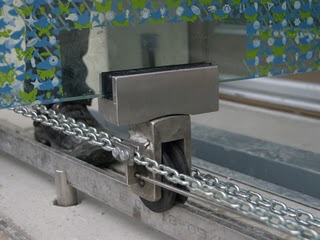
Hello everyone out in the internets!
So I'm currently working on a precedent study for my upcoming trip to Vancouver, BC and thought I would put a few questions to the masses.
The project I've decided to look at is the Lanchid 19 Design Hotel in Budapest, Hungary; and specifically I'm looking at the kinetic glass facade that is on the river side. It's a fancy-pants project with lots of glitz and glamor, but this facade while rather superfluous has been a lot of fun to analyze and discover how it works.

I'm not at all familiar with mechanics (yet) and have been looking at this mechanism for a few hours now and feel like I have a good grasp of what is going on. Here's a video of the facade in action.
So far I've been able to determine that the glass does two things, first and most obviously, it spins. Second, and not so clear from some of the videos, it slides horizontally.
This system is made up of 150 glass panels, (all uniquely screen printed) 25 sets of 6 glass panels which have two distinct mechanical systems, (one to spin, and one to open) and all this is controlled by a "meteo-sensor" that takes data from the surrounding environment and somehow interpolates that into various lighting and rotation patterns.
There is some really great documentation and resources showing the process and construction of this building at the projects blog. (this is where all these photographs are taken from) It looks to be a very successful collaboration with a number of engineers, designers, and software developers.
Now, the reason that I'm putting this up here, is because I'm stumped on a few things. I've emailed the robotics company who designed the system, as well as one of the other designers who worked on this project but haven't yet heard back, so maybe you all might have a clue.
First, as I understand it, the system is set up into 'racks' of 6 glass panels. Each of these racks have two separate motors to control each function of the panel (spinning and sliding).
The sliding seems the most straight forward as it looks to have a chain drive that loops around the whole system, and as it spins pulls back the panels at key attachment points. There are then guiding rods, that regulate how close the panels can get to one another, as well as allow the panels to slide open with a single direction motor, and slide back closed by reversing the motors direction. 


The spinning on its own seems rather simple though I'm still struggling with how the chain drive spins all 6 panels at the same time. What I know is that the motor is located in the center with three panels on either side, and is likely a right angle gear, or worm gear that transfers the rotation 90 degrees similar to the sliding mechanism. Additionally, I know this all takes place at the top of the panel, while the bottom panel simply spins on its attachment point. It is really hard for me to tell what is going on because the mechanism is enclosed in a steel casement that also serves as the guide rail, so it is not as easily understood as the lower portion of the system. Here is a picture of the motor that spins the panels. 
This is the only picture I could find of the top panel, and other than a few others that are taken from the ground you really can't see what is happening up there. Here's a video of the prototype:
I also haven't yet figured out how these two systems are coordinated. My theory about the spinning panels was that they are chain driven and the chain wraps around each bracket similar to the bottom pieces, and this allows them all to spin simultaneously, but if this were the case, what would happen to the chain when you slide the panels open? The chain would loosen up and potentially be caught or disconnect. I think I'm missing something pretty basic because my knowledge of simple machinery is rather limited. If anyone has any suggestions about this, I'm still working on figuring this out so please feel free to comment.
(I've been using Google's "Translate" to read the websites and blogs about this project so I may be losing some important info in the translation)



4 Comments
I haven't translated the info from the pages you linked, but in the prototype video, the panels appear to be spinning without use of the chain on the bottom. this means some system in the upper connection is probably responsible for the spinning of the panels, which could be another, distinct chain system or individual motors (can't tell since that area is enclosed).
the bottom chain could very well be the part that separates and condenses the panels, but it's hard to say from the pictures and videos what, if any, coiling mechanism is being used to retract them when turning in one direction and extending them in the other, if that is, indeed, what is happening.
i think that the mechanics could probably be created through a variety of creative methods.
the systems aren't directly linked. the spinning is one system, the sliding is another. it doesn't appear that the 6 panes in one group can slide in different directions, i think that video is 2 groups sliding in opposite directions...
you're probably overthinking it - it is the computer system responding to environmental factors that is overly complex.
the motors for the spinning/sliding mechanism are simple electric motors. linking one motor to spin 6 panes should be fairly simple.
hidromatic's site shows the drives as bonfiglioli's
Thanks for the comments.
aveclaudenum: You're right, the chain only slides the windows open, and there are two sets of these at the top and bottom. I was sure that these didn't spin the panels, but from what I wrote in the post that didn't come across very clearly. I initially thought that there was a separate chain drive that spun the windows also, but that was incorrect.
holz.box: You are correct that the systems are two separate systems, and each system is it's own set of 6 panels. You can see from the diagram in this post how a single system would operate this mechanism. Also, I did notice that they were Bonfiglioli motors; I was interested more in the exact mechanism that is was used to get this result.
I've heard back from the designers, and he sent me a few mechanical drawings. What it shows is that my initial understanding of the collapsing system was correct, while the spinning is controlled by a separate engine with a bevel gear at each glass panel.
Where I was caught up was where these two systems interacted because the spinning has to stop when the windows open up. What seems to happen is that the bevel gear in each panel stays engaged, but it disengages from the motor so the drive shaft spins freely as the windows move apart. This makes sense as then you don't have the chance for error when reengaging the spinning glass.
I'm still pretty sure that the windows spin only one direction which would simplify the driving mechanism even more.
I'm going to have to diagram these two separate systems, as well as explain how they interact with one another for class, so I'll go ahead and put up another post soon.
Daniel: I noticed in your diagram that you had spacers keeping uniform distance between panels. I don't think this is the case because of how the panels can condense, show here (towards the middle):
http://tinyurl.com/ygyoepm
I think there might be locking pins connected to each joint in the upper system that are released when the panels are condensed, but I'm not sure. The drawings you have could very well contradict this.
Block this user
Are you sure you want to block this user and hide all related comments throughout the site?
Archinect
This is your first comment on Archinect. Your comment will be visible once approved.